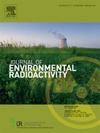在异常检测中结合民用放射性氙背景估计
IF 2.1
3区 环境科学与生态学
Q3 ENVIRONMENTAL SCIENCES
引用次数: 0
摘要
2023年的核爆炸筛查工作(Maurer等人,2023年)发现了识别相对于背景浓度升高的异常放射性氙活动浓度的挑战。通过将样品与核反应堆或医用同位素生产设施释放造成的大气放射性氙背景浓度估估值进行比较,继续研究检测异常放射性氙浓度的方法。一种新的方法是利用优化技术获得的随时间变化的放射性氙释放率来估计样品浓度,这种优化技术将设施释放率限制在基于历史数据或设施知识的合理数量上。优化的目的是确定来自发射设施的合理释放率的任何组合是否可以解释一个或多个采样站的一系列放射性氙测量结果。一个案例研究使用了2021年在西欧三个地点收集的一个月的放射性氙数据,并考虑了77个地点的释放。与应用目前的国际监测系统(IMS)活动浓度水平规则相比,使用简单的标记规则确定为异常的样本较少。本文章由计算机程序翻译,如有差异,请以英文原文为准。
Incorporating civilian radioxenon background estimates in anomaly detection
A nuclear explosion screening exercise in 2023 (Maurer et al., 2023) found challenges with discerning anomalous radioxenon activity concentrations relative to elevated background concentrations. Research has continued into methods to detect anomalous radioxenon concentrations by comparing samples to estimates of atmospheric radioxenon background concentrations caused by releases at nuclear reactors or medical isotope production facilities. A new approach estimates the sample concentrations using time-varying radioxenon release rates obtained using optimization techniques that constrain the facility release rates to plausible amounts based on historical data or facility knowledge. The purpose of the optimization is to determine whether any combination of plausible release rates from emitting facilities can explain a series of radioxenon measurements at one or more sampling stations. A case study uses radioxenon data collected at three locations in western Europe for a month in 2021 and considers releases from 77 locations. Fewer samples are identified as being anomalous using a simplistic flagging rule than from an application of the current International Monitoring System (IMS) activity concentration-level rule.
求助全文
通过发布文献求助,成功后即可免费获取论文全文。
去求助
来源期刊

Journal of environmental radioactivity
环境科学-环境科学
CiteScore
4.70
自引率
13.00%
发文量
209
审稿时长
73 days
期刊介绍:
The Journal of Environmental Radioactivity provides a coherent international forum for publication of original research or review papers on any aspect of the occurrence of radioactivity in natural systems.
Relevant subject areas range from applications of environmental radionuclides as mechanistic or timescale tracers of natural processes to assessments of the radioecological or radiological effects of ambient radioactivity. Papers deal with naturally occurring nuclides or with those created and released by man through nuclear weapons manufacture and testing, energy production, fuel-cycle technology, etc. Reports on radioactivity in the oceans, sediments, rivers, lakes, groundwaters, soils, atmosphere and all divisions of the biosphere are welcomed, but these should not simply be of a monitoring nature unless the data are particularly innovative.
 求助内容:
求助内容: 应助结果提醒方式:
应助结果提醒方式:


